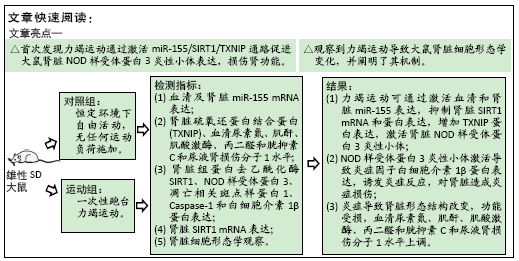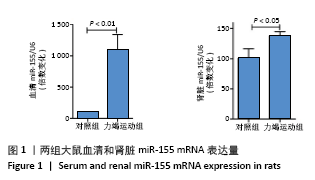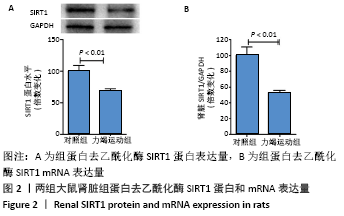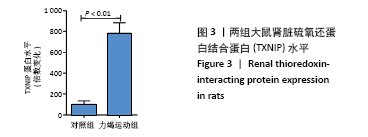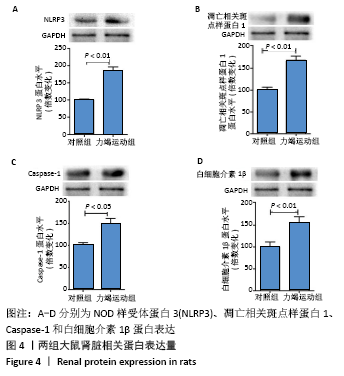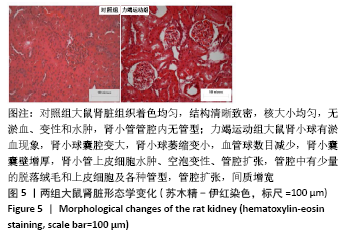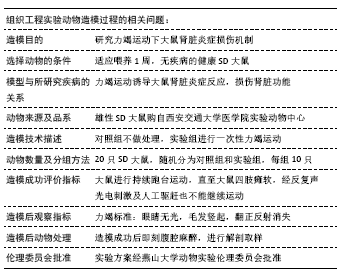[1] 陈丽娜,周刚,吴乐,等.力竭运动对大鼠肾脏的影响[J].中国康复理论与实践,2016,22(7):789-792.
[2] 林喜秀,邱继旺,罗自强,等.急性力竭运动模型大鼠鱼腥草素干预后的肾滤过屏障变化[J].中国组织工程研究,2014,18(36): 5793-5798.
[3] RAO Z, ZHENG L, HUANG H, et al. α-Klotho Expression in Mouse Tissues Following Acute Exhaustive Exercise. Front Physiol. 2019;10:1498.
[4] TSCHOPP J, MARTINON F, BURNS K. NALPs: a novel protein family involved in inflammation. Nat Rev Mol Cell Biol. 2003;4(2):95-104.
[5] KIM HJ, LEE DW, Ravichandran K, et al. NLRP3 inflammasome knockout mice are protected against ischemic but not cisplatin-induced acute kidney injury. J Pharmacol Exp Ther. 2013;346(3):465-472.
[6] SCHRODER K, ZHOU R, TSCHOPP J. The NLRP3 inflammasome: a sensor for metabolic danger? Science. 2010;327(5963):296-300.
[7] BAI M, CHEN Y, ZHAO M, et al. NLRP3 inflammasome activation contributes to aldosterone-induced podocyte injury. Am J Physiol Renal Physiol. 2017;312(4):F556-F564.
[8] LI H, MIAO W, MA J, et al. Acute Exercise-Induced Mitochondrial Stress Triggers an Inflammatory Response in the Myocardium via NLRP3 Inflammasome Activation with Mitophagy. Oxid Med Cell Longev. 2016; 2016:1987149.
[9] 林琴琴,耿元文,田振军.白藜芦醇对一次性力竭运动大鼠心肌NLRP3炎性小体表达的影响[J].北京体育大学学报,2018,41(6): 57-62.
[10] 焦春利,徐鹏,曹雪滨.运动预适应调控力竭运动大鼠NLRP3炎性体信号通路保护心肌的机制研究[J]. 中华危重病急救医学,2016, 28(7):618-623.
[11] MAHESH G, BISWAS R. MicroRNA-155: A Master Regulator of Inflammation. J Interferon Cytokine Res. 2019;39(6):321-330.
[12] ZHENG C, ZHANG J, CHEN X, et al. MicroRNA-155 Mediates Obesity-Induced Renal Inflammation and Dysfunction. Inflammation. 2019; 42(3):994-1003.
[13] WU H, HUANG T, YING L, et al. MiR-155 is Involved in Renal Ischemia-Reperfusion Injury via Direct Targeting of FoxO3a and Regulating Renal Tubular Cell Pyroptosis. Cell Physiol Biochem. 2016;40(6):1692-1705.
[14] WU X, CHANG SC, JIN J, et al. NLRP3 in flammasome mediates chronic intermittent hypoxia-induced renal injury implication of the microRNA-155/FOXO3a signaling pathway. J Cell Physiol. 2018;233(12): 9404-9415.
[15] KONG L, WU H, ZHOU W, et al. Sirtuin 1: A Target for Kidney Diseases. Mol Med. 2015;21:87-97.
[16] LIN QQ, GENG YW, JIANG ZW, et al. SIRT1 regulates lipopolysaccharide-induced CD40 expression in renal medullary collecting duct cells by suppressing the TLR4-NF-kappaB signaling pathway. Life Sci. 2017;170: 100-107.
[17] YANG SY, LIN SL, CHEN YM, et al. Downregulation of angiotensin type 1 receptor and nuclear factor-kappaB by sirtuin 1 contributes to renoprotection in unilateral ureteral obstruction. Sci Rep. 2016;6: 33705.
[18] LI Y, YANG X, HE Y, et al. Negative regulation of NLRP3 inflammasome by SIRT1 in vascular endothelial cell. Immunobiology. 2017;222(3):552-561.
[19] JIANG L, ZHANG L, KANG K, et al. Resveratrol ameliorates LPS-induced acute lung injury via NLRP3 inflammasome modulation. Biomed Pharmacother. 2016;84: 130-138.
[20] WANG Y, ZHENG ZJ, JIA YJ, et al. Role of p53/miR-155-5p/sirt1 loop in renal tubular injury of diabetic kidney disease J Transl Med. 2018;16(1): 146.
[21] 谢文杰,周刚,谢金美,等.一次性力竭运动模型大鼠心肌氧化损伤的作用途径[J].中国组织工程研究,2021,25(2):247-252.
[22] ICHIMURA T, HUNG CC, YANG SA, et al. Kidney injury molecule-1: a tissue and urinary biomarker for nephrotoxicant-induced renal injury. Am J Physiol Renal Physiol. 2004;286(3): F552-563.
[23] HERGET-ROSENTHAL S, MARGGRAF G, HUSING J, et al. Early detection of acute renal failure by serum cystatin C. Kidney Int. 2004;66(3): 1115-1122.
[24] WEN Y, LIU YR, TANG TT, et al. mROS-TXNIP axis activates NLRP3 inflammasome to mediate renal injury during ischemic AKI. Int J Biochem Cell Biol. 2018;98:43-53.
[25] FERNANDEZ-SANJURJO M, DE GONZALO-CALVO D, FERNANDEZ-GARCIA B, et al. Circulating microRNA as Emerging Biomarkers of Exercise. Exerc Sport Sci Rev. 2018;46(3):160-171.
[26] POLAKOVICOVA M, MUSIL P, LACZO E, et al. Circulating MicroRNAs as Potential Biomarkers of Exercise Response. Int J Mol Sci. 2016;17(10): 1553.
[27] XU T, LIU Q, YAO J, et al. Circulating microRNAs in response to exercise. Scand J Med Sci Sports. 2015;25(2):e149-154.
[28] BAGGISH AL, HALE A, WEINER RB, et al. Dynamic regulation of circulating microRNA during acute exhaustive exercise and sustained aerobic exercise training. J Physiol. 2011;589(Pt 16):3983-3994.
[29] XU T, ZHOU Q, CHE L, et al. Circulating miR-21, miR-378, and miR-940 increase in response to an acute exhaustive exercise in chronic heart failure patients. Oncotarget. 2016;7(11):12414-12425.
[30] PASTUSZAK-LEWANDOSKA D, DOMAŃSKA-SENDEROWSKA D, KISZAŁKIEWICZ J, et al. Expression levels of selected cytokines and microRNAs in response to vitamin D supplementation in ultra-marathon runners. Eur J Sport Sci. 2020;20(2):219-228.
[31] OGURA S, SHIMOSAWA T. Oxidative stress and organ damages. Curr Hypertens Rep. 2014;16(8):452.
[32] SAIKUMAR J, HOFFMANN D, KIM TM, et al. Expression, circulation, and excretion profile of microRNA-21, -155, and -18a following acute kidney injury. Toxicol Sci. 2012;129(2):256-267.
[33] LIN X, YOU Y, WANG J, et al. MicroRNA-155 deficiency promotes nephrin acetylation and attenuates renal damage in hyperglycemia-induced nephropathy. Inflammation. 2015;38(2):546-554.
[34] KLIMCZAK D, KUCH M, PILECKI T, et al. Plasma microRNA-155-5p is increased among patients with chronic kidney disease and nocturnal hypertension. J Am Soc Hypertens. 2017;11(12):831-841.
[35] BELTRAMI C, SIMPSON K, JESKY M, et al. Association of Elevated Urinary miR-126, miR-155, and miR-29b with Diabetic Kidney Disease. Am J Pathol. 2018;188(9):1982-1992.
[36] 李方,曹建民,王传军,等.白藜芦醇通过调节SIRT1/NF-κB通路减轻力竭训练致大鼠肾的炎症反应[J].中国生物化学与分子生物学报,2019,35(7):773-779.
[37] HUANG X, SHI Y, CHEN H, et al. Isoliquiritigenin prevents hyperglycemia-induced renal injuries by inhibiting inflammation and oxidative stress via SIRT1-dependent mechanism. Cell Death Dis. 2020;11(12):1040.
[38] CHOU X, DING F, ZHANG X, et al. Sirtuin-1 ameliorates cadmium-induced endoplasmic reticulum stress and pyroptosis through XBP-1s deacetylation in human renal tubular epithelial cells. Arch Toxicol. 2019;93(4):965-986.
[39] CHEN L, LAN Z. Polydatin attenuates potassium oxonate-induced hyperuricemia and kidney inflammation by inhibiting NF-κB/NLRP3 inflammasome activation via the AMPK/SIRT1 pathway. Food Funct. 2017;8(5):1785-1792.
[40] PARK JE, LEE H, KIM SY, et al. Lespedeza bicolor Extract Ameliorated Renal Inflammation by Regulation of NLRP3 Inflammasome-Associated Hyperinflammation in Type 2 Diabetic Mice. Antioxidants (Basel). 2020;9(2):148.
[41] WU M, LI R, HOU Y, et al. Thioredoxin-interacting protein deficiency ameliorates kidney inflammation and fibrosis in mice with unilateral ureteral obstruction. Lab Invest. 2018;98(9):1211-1224.
[42] KUMAR A, MITTAL R. Mapping Txnip: Key connexions in progression of diabetic nephropathy. Pharmacol Rep. 2018;70(3):614-622.
[43] WU Y, HE F, LI Y, et al. Effects of Shizhifang on NLRP3 Inflammasome Activation and Renal Tubular Injury in Hyperuricemic Rats. Evid Based Complement Alternat Med. 2017;2017:7674240.
[44] WANG M, ZHAO J, ZHANG N, et al. Astilbin improves potassium oxonate-induced hyperuricemia and kidney injury through regulating oxidative stress and inflammation response in mice. Biomed Pharmacother. 2016;83:975-988.
[45] XU L, LIN X, GUAN M, et al. Verapamil Attenuated Prediabetic Neuropathy in High-Fat Diet-Fed Mice through Inhibiting TXNIP-Mediated Apoptosis and Inflammation. Oxid Med Cell Longev. 2019; 2019:1896041.
[46] CHOI SE, KEMPER JK. Regulation of SIRT1 by microRNAs. Mol Cells. 2013;36(5):385-392.
[47] LU S, DONG L, JING X, et al. Abnormal lncRNA CCAT1/microRNA-155/SIRT1 axis promoted inflammatory response and apoptosis of tubular epithelial cells in LPS caused acute kidney injury. Mitochondrion. 2020;53:76-90. |
